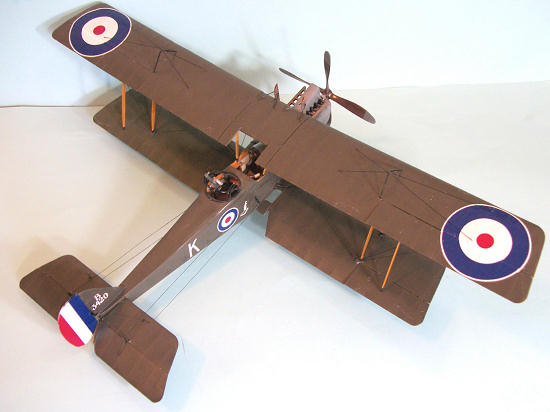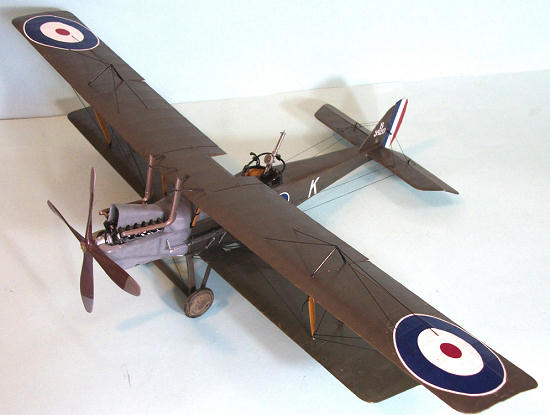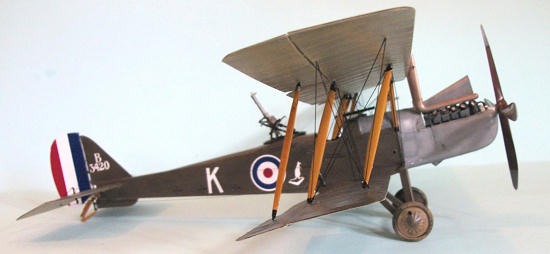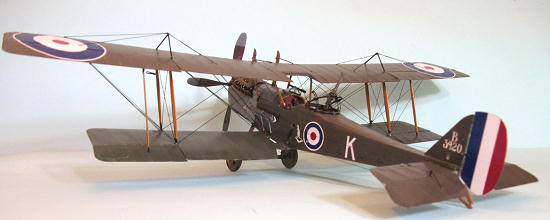Wingnut Wings 1/32 RE.8 'arry Tate
|
KIT #: |
32012 |
|
PRICE: |
$89.00 direct |
|
DECALS: |
Five options |
|
REVIEWER: |
Tom Cleaver |
|
NOTES: |
|

The Royal
Aircraft Factory at Farnborough was established in 1911 to experiment on
aircraft designs and provide information for the rest of the new aircraft
industry. The RAF also produced its
designs, all of which save the S.E.5a (for Scout Experimental) were of
remarkably unimaginative design, and mostly contributed to the retardation of
technical development of aircraft for the Royal Flying Corps.
The roots of "'Arry Tate," as the R.E. 8 (Reconnaissance
Experimental, Model 8) was known to its crews, goes back to the creation of the
B.E. (for Bleriot Experimental) series.
The B.E.2, which appeared in B.E.2c, B.E.2d and B.E.2e versions, was the
primary corps reconnaissance aircraft of the Royal Flying Corps from 1914 until
the R.E.8 began to replace it on the Western Front in late 1916.
It was a pilot in a B.E.2 who first spotted the German army shortly after
it had turned left toward Paris as it came out of Belgium; that his warning was
taken seriously by a ground commander was as big a miracle in itself as the
"Miracle of the Marne" it led to by allowing the British Expeditionary Force to
withdraw before being surrounded and for the French to use the
 taxis of Paris to
get men to hold on the Marne. The
First World War would have been the six week conflict everyone expected ‑ and
ended with German victory ‑ but for that lone pilot in his already‑ obsolete
airplane.
taxis of Paris to
get men to hold on the Marne. The
First World War would have been the six week conflict everyone expected ‑ and
ended with German victory ‑ but for that lone pilot in his already‑ obsolete
airplane.
The B.E.2 made
the serious design mistake of putting the pilot in the back seat; at a time when
aircraft were unarmed and unlikely to be armed, putting the observer in front
supposedly gave him a better field of view.
When it came time to arm airplanes against the "Fokker scourge," the
observer was provided with a Lewis gun on a pivot between the two cockpits, with
a limited field of fire directly to the rear, over the pilot's head.
With a top speed of 75‑80 m.p.h., the B.E.2s were sitting ducks for
German Jagdflieger mounted in Albatros fighters, and they were shot down
in droves during the Somme campaign in the summer and fall of 1916 and on
through Bloody April in 1917, when the average operational life of an R.F.C.
pilot was 7 hours once he arrived at the front with as little as 20 hours total
flying time and was assigned to a squadron equipped with the type.
"'Arry Tate" was
not that much of an improvement over his
predecessor. The airplane came into
existence in 1916 as a
result of the perceived need to create an airplane with superior performance and
hence better survivability than the B.E. series.
Among the B.e. characteristics the R.e.8 maintained was its “inherent
stability,” which was said to improve the work of the observer when doing aerial
photography. This stability didn't
extend to the landing characteristics: it was difficult to land at the stall,
due to the torque of the big propeller which would cause the aircraft to yaw
dangerously to the right; this was controlled by the rudder, but it caused much
concern among pilots new to the R.E.8.
The main item of improvement was that the seating order was reversed,
with pilot and observer/gunner seated back‑to‑back which allowed better
coordination; the gunner's weapons were mounted on a Scarff ring that allowed a
full 360 degree field of fire, with either one or two Lewis guns.
While the addition of a second weapon added to an already‑heavy load, the
fact that the R.E.8 only had a top speed of 90‑95mph meant many crews decided
they would give the enemy a hot reception since it was unlikely they could run
away. The R.E.8 began to replace
the B.E. in the corps reconnaissance squadrons in late 1916, and had a survival
rate during "Bloody April"
of 1917 slightly better than the B.E.‑equipped units, due to its improved
defensive armament. By that summer,
the aircraft had replaced all of the dreadful B.E.s on the Western Front, and
had also been adopted by the Belgian Air Force.
 By early 1918, the production level of the far‑better
Bristol
F.2B Fighter ‑ which had originally been designed as a
competitor to the
R.E.8 ‑ had reached the point it could be
diverted to the corps reconnaissance squadrons, and it began to replace the
R.E.8 on the Western Front. The
airplane continued in widespread use in the
Middle East,
and was never completely supplanted on the Western Front before the end of the
war.
By early 1918, the production level of the far‑better
Bristol
F.2B Fighter ‑ which had originally been designed as a
competitor to the
R.E.8 ‑ had reached the point it could be
diverted to the corps reconnaissance squadrons, and it began to replace the
R.E.8 on the Western Front. The
airplane continued in widespread use in the
Middle East,
and was never completely supplanted on the Western Front before the end of the
war.
Little is made of the fact nowadays that there were in fact many “gunner
aces” among the R.F.C. and R.A.F. during the First World War, including quite a
few with double-digit scores and a several with scores over 20; the overwhelming
majority of these gunner aces were rear-seaters on Bristol Fighters, an airplane
that genuinely was a two-seat fighter.
Among the more memorable of these men is Lt. Harvey Rhoads of 12
Squadron, who - between May 7 and
September 3, 1918
- scored an amazing eleven victories as the observer in an R.E.8, the only R.E.8
gunner to score sufficient victories to be recorded in the record books.
Flying with Lt. Croye Pithey in B7715 and Lt. Noel Garland in F6097,
Rhoads shot down two observation balloons, three Pfalz D.IIIs, two Fokker
D.VIIs, a DFW C.V and two LVG two-seaters.
When one considers the kind of defenses that were mounted around
observation balloons, the fact that Rhoads and Pithey destroyed two on separate
occasions in May and June 1918 demonstrates some very great courage and superior
skill, as well as an enormous helping of luck.
Obviously, ‘Arry Tate wasn-t always a target.
Over 4,000 R.E.8s were built by several subcontractors, and served in
eighteen RFC and RAF Squadrons as well as two squadrons of the Australian Flying
Corps.
The Australian Flying Corps used the R.E.8 operationally in No.1 and No.3
Squadrons. No. 3 Squadron used the
R.E.8 during its service on the Western Front during the last year of the war
from September 1917. Over that
time, 104 R.E.8s served with the unit, an indication of the heavy use, since
only eleven were lost in combat.
R.E.8 A4397, flown by Captain R.G. Francis, set a
Western Front record of service with 440 hours and 147 sorties over the
front lines. Between September 1917
and the end of the war, No.3 Squadron flew over 10,000 hours, dropped 6,000
bombs, fired half a million rounds, and photographed 120 square miles of German
territory. For a loss of eleven
aircraft and their crews, No. 3 was credited with 16
enemy aircraft destroyed, 8 driven down out of control, and 27 forced
down. Following the Armistice, No.
3 helped institute air mail, flying throughout France and Belgium, until the
unit was demobilized and returned to Australia in 1919.
Perhaps the most famous story of the R.E.8 in Australian service is that
of the “Ghost R.E.8.” On December 16, 1917, Lieutenant J. L. Sandy and Sergeant
H. F. Hughes were observing artillery fire when they were attacked by six
Albatross D.Va Scouts. Sandy
refused to dive away and engaged the enemy, bringing down one that landed intact
in Australian lines north of Armentieres.
 Another R.E.8 aircraft of 3 squadron crewed by Lieutenant E. J. Jones and
Lieutenant K.C. Hodgson, went to the assistance of Sandy and Hughes and the
surviving Germans flew off.
Approaching Sandy-s airplane, Sandys and Hughes appeared all right. Jones
returned to his mission.
Another R.E.8 aircraft of 3 squadron crewed by Lieutenant E. J. Jones and
Lieutenant K.C. Hodgson, went to the assistance of Sandy and Hughes and the
surviving Germans flew off.
Approaching Sandy-s airplane, Sandys and Hughes appeared all right. Jones
returned to his mission.
By dusk, Sandy and Hughes had not returned.
Inquiries were made at other aerodromes, but there was no word.
The next day a telegram was received from No. 12 Stationary Hospital, St.
Pol, that the bodies of Sandy and Hughes had been found in a crashed R.E.8
aircraft in a field about 8 kilometers north‑east of St. Pol.
An armor-piercing bullet had passed through Hughes- left lung and into
the base of Sandy-s skull, killing them instantly during the combat. They had
not been injured in the landing crash, and damage to the aircraft was minor.
It appeared that after the
crew had been killed, the R.E.8 had flown itself in wide left‑hand circles until
the gas ran out, with the wind blowing it to the southwest.
The site of the crash was 50 miles from the location of the battle.
The Albatros brought down by Sandy Hughes was recovered by a party of
mechanics under Captain Ross under shell fire on the night of December 17/18 and
brought back to 3 Squadron-s aerodrome.
It was D5390/17 of Jasta 29, flown by Franz Claus.
After being test flown in England, it was presented to the Australian
Government as a War Trophy. It is
today on display in the Australian War Memorial.
 There have only been two other kits released of the R.E.8: an ancient
1/72 kit by Airfix in the late 1950s, and a very nice limited-run kit by
Aeroclub in 1995. This kit by
Wingnut Wings is the first mainstream injection-molded kit of the airplane in
1/32, and it is easily the best of the lot. Editor's Note: Speaking of
models, those who are in San Diego, visit the Aerospace Museum. In the WWI
section is a huge 1/48 Zeppelin being attacked by one of these aircraft. I am
sure both were scratch-built.
There have only been two other kits released of the R.E.8: an ancient
1/72 kit by Airfix in the late 1950s, and a very nice limited-run kit by
Aeroclub in 1995. This kit by
Wingnut Wings is the first mainstream injection-molded kit of the airplane in
1/32, and it is easily the best of the lot. Editor's Note: Speaking of
models, those who are in San Diego, visit the Aerospace Museum. In the WWI
section is a huge 1/48 Zeppelin being attacked by one of these aircraft. I am
sure both were scratch-built.
The kit arrives in the box with ten sprues in grey plastic and one in
clear, with a photo-etch panel for the pilot-s seatbelt and various detail items
for the guns. Decals are provided
for five different aircraft. The
differences between aircraft produced by sub-contractors, such as Daimler,
Siddeley-Deasy and Austin are included, and the instructions are clear as to
which go where for the model selected.
There are lots of spare parts, including bombs and machine guns, for the
spares box and future use.
 As is usual with a Wingnut Wings kit, if the modeler commits the radical
and frequently-unthinkable act of actually following the instructions as
written, it is virtually guaranteed that a superb model will result.
In fact, this is what I did.
As is usual with a Wingnut Wings kit, if the modeler commits the radical
and frequently-unthinkable act of actually following the instructions as
written, it is virtually guaranteed that a superb model will result.
In fact, this is what I did.
It-s a good idea to paint as many parts as possible while they are still
on the sprues. This is easy, with
the excellent paint call-outs included in the instructions.
After all had dried, I proceeded with the assembly according to the steps
outlined in the instruction book.
Once I had the fuselage as a complete sub-assembly, I proceeded to paint the
model.
I “filled in” the space between ribs on the wings and tail planes with
flat black for pre-shading, then painted the lower surfaces with Tamiya “Buff”
and the upper surfaces with Tamiya “Khaki.”
The engine cowling was painted with Tamiya “Sky Grey.”
The interplane struts and the cabane struts were painted with my mixture
for “Ash”, being a combination of Tamiya “Flat Brown,” “Orange” and “Flat
Yellow.” The metal parts were
painted with Tamiya “Semi-Gloss Black.”
Once all was done, I gave the model a coat of Xtracrylix “Gloss” varnish.
I chose to do the airplane on the box cover, a Daimler-built R.e.8
operated by 3 Squadron,
AFC.
The excellent decals went on without problem under a coat of Micro-Sol.
I then gave the model a coat of Xtracrylix “Satin” varnish.
 I attached the engine and then glued the cowling covers in position.
I then attached the pilot-s Vickers gun with its mounting brackets and
the telescopic sight.
I attached the engine and then glued the cowling covers in position.
I then attached the pilot-s Vickers gun with its mounting brackets and
the telescopic sight.
I attached the lower wing and tail surfaces, after gluing the elevators
and ailerons in offset positions. I
then attached the main gear, and proceeded to glue the interplane atruts and
cabane struts in position. Once all
was set, I glued the top wing in position.
Rigging was done with .008 wire, painted black.
The wheels were “muddied” and then glued in position, followed by the
bomb rack rails and finally the Scarff ring with its single Lewis gun mounted.
I don-t really know why, but I have liked the R.E.8 ever since I built a
carved balsa-wood model of one from t he William Wylam drawings in a Model
Airplane News issue back in my youth.
I have built both the Airfix and Aeroclub kits over the years, and really
appreciate this model. As is usual
with Wingnuts Wings kits, even a model as potentially difficult as the R.E.8
could be is an easy model for a modeler with average skills to build, due to the
“buildability” of the production design.
The end result, as with all the other Wingnuts kits, is an excellent
model of a well-known First World War airplane.
British biplanes of the period had considerably more rigging than did
German aircraft, so you should have some experience with that and confidence in
your ability in order to complete this model.
That said, anyone who takes their time and follows the instructions can
be assured of a superb model for their collection.
Highly recommended.
he William Wylam drawings in a Model
Airplane News issue back in my youth.
I have built both the Airfix and Aeroclub kits over the years, and really
appreciate this model. As is usual
with Wingnuts Wings kits, even a model as potentially difficult as the R.E.8
could be is an easy model for a modeler with average skills to build, due to the
“buildability” of the production design.
The end result, as with all the other Wingnuts kits, is an excellent
model of a well-known First World War airplane.
British biplanes of the period had considerably more rigging than did
German aircraft, so you should have some experience with that and confidence in
your ability in order to complete this model.
That said, anyone who takes their time and follows the instructions can
be assured of a superb model for their collection.
Highly recommended.
Tom
Cleaver
April 2012
Copyright ModelingMadness.com. All rights reserved. No reproduction in part or in whole without express permission from the editor.If you would like your product reviewed fairly and fairly quickly, please contact the editor or see other details in the
Note to
Contributors.
Back to the Main Page
Back to the Review
Index Page 2025


 taxis of Paris to
get men to hold on the Marne. The
First World War would have been the six week conflict everyone expected ‑ and
ended with German victory ‑ but for that lone pilot in his already‑ obsolete
airplane.
taxis of Paris to
get men to hold on the Marne. The
First World War would have been the six week conflict everyone expected ‑ and
ended with German victory ‑ but for that lone pilot in his already‑ obsolete
airplane.


 There have only been two other kits released of the R.E.8: an ancient
1/72 kit by Airfix in the late 1950s, and a very nice limited-run kit by
Aeroclub in 1995. This kit by
Wingnut Wings is the first mainstream injection-molded kit of the airplane in
1/32, and it is easily the best of the lot.
There have only been two other kits released of the R.E.8: an ancient
1/72 kit by Airfix in the late 1950s, and a very nice limited-run kit by
Aeroclub in 1995. This kit by
Wingnut Wings is the first mainstream injection-molded kit of the airplane in
1/32, and it is easily the best of the lot.
 I attached the engine and then glued the cowling covers in position.
I then attached the pilot-s Vickers gun with its mounting brackets and
the telescopic sight.
I attached the engine and then glued the cowling covers in position.
I then attached the pilot-s Vickers gun with its mounting brackets and
the telescopic sight.